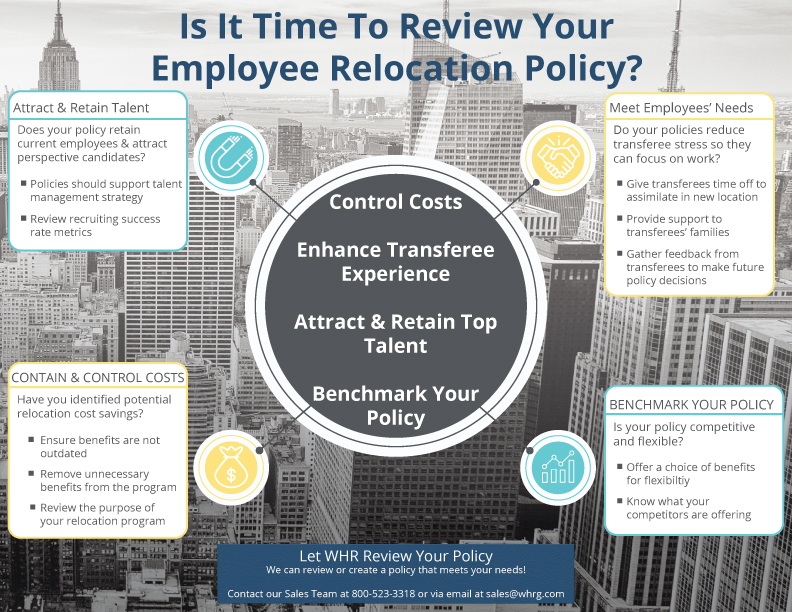Given the many changes businesses have encountered from COVID-19, including employees working remotely, you might think there’s no reason to review your company’s employee relocation policy right now. Well, think again. Many companies are still relocating employees to fill needed roles. Reviewing your policy and making needed adjustments now can help your organization in the following areas:
- ビジネスコストのコントロール
- 従業員のニーズを満たすために
- 優秀な人材の確保と定着
- ベンチマーキング競合他社に対する自社のポリシー
The following examples are from policy reviews WHR Global conducted for its clients. These examples demonstrate just how important it is to review your relocation policy on a regular basis.
A.ビジネスコストをコントロールし、不要な福利厚生の支払いをやめる。
Make sure you’re allocating the right amount of dollars to both transferees and organizational needs. It’s also essential that you’re not paying for unnecessary or outdated benefits.
- 例1
ある会社では、転勤者全員に転勤一時金として5千-1万ドルを支給し、余分な経費を補助していた。また、5,000~10,000ドルの一時金に加え、6週間の給与に相当する一時金を役員に支給していました。エグゼクティブの中には高給取りもいるため、この手当はエグゼクティブ一人当たり5万ドルにもなることもありました。検討の結果、私たちはその役員に対するこの慣習を減らすよう会社に提案しました。その結果、同社は数十万ドルを節約することができました。 - Example #2
A client was paying a cost of living differential if the employee was relocating to a higher cost area. They were paying this out for 3–4 years, plus they were also providing a big lump sum benefit. We recommended a minimum 5% cost of living threshold so that they were not paying transferees moving to only slightly higher cost of living areas. The client saved millions. - Example #3
Another client was giving out non-promotional bonuses to current employees willing to relocate for a lateral role. These bonuses equated to 5% of the employees’ salaries. Since this practice is not common, we recommended they eliminate this from their relocation policy, which saved them significant costs without lowering the value of their program. - Example #4
One of our clients was paying a loan origination fee. Some lenders don’t even charge this fee, but if they know the client will pay, they will still charge the fee anyway. Once the client realized this, they stopped paying the fee unless necessary.
B.従業員のニーズに応える
It’s important that your relocation policy meets your transferees’ needs. This helps to reduce transferee stress so that employees can focus on work in their new location. Giving transferees time off to assimilate in their new location, providing support to transferees’ families, and gathering post-relocation feedback to make future policy decisions will all help to address your transferees’ needs.
- Example #1
One of our clients was offering a lump sum benefit for all international relocations. By gathering post-relocation survey feedback, we found out transferees were trying to coordinate their own international household goods (HHG) shipments and were not spending the full lump sum, in hopes of keeping some money. The survey feedback also showed that giving employees that level of choice was adding more stress on them, and it was making the relocation process take longer. Basically, transferees were trying to do it all on their own plus pinch pennies. The client considered all key benefits and determined the lump sum was not working. They shifted from a lump sum to a core flex benefit. This meant the client would cover HHG shipments, destination service providers and temporary housing, but they still gave transferees a lump sum amount to be used at the employees’ discretion. Not only did this help reduce transferee stress, but it also helped control business costs.
- Example #2
One client was not offering destination services to the spouses/partners and families of intra-European moves. They assumed that if a transferee/family was relocating from Russia to the UK, for example, destination services were not needed. Through post-relocation survey feedback, it was determined that spouses/partners required career assistance, language training and help with school searches for their children. The employee had office workers to help them assimilate in the new locations, but the transferees’ partners were struggling with the new language and even struggling to find necessities like grocery stores. Recognizing the needs of the entire family unit, and not just the transferee, is crucial to ensuring a successful move and assimilation.
C.人材の確保と維持、競合他社に対する自社ポリシーのベンチマーク
転勤対策は、すでに貴社の総合的な報酬と人材管理戦略の一部になっていることを期待します。適切な方針は、御社が現在の従業員を維持し、将来性のある候補者を惹きつけるのに役立ちます。脆弱な転勤対策は、採用の成功率にマイナスの影響を与える可能性があります。
Benchmarking your policy against other companies will help you stay competitive in the war for talent. Make sure your policy provides a choice of offerings, since relocation policies are wrapped into job offers. If you don’t benchmark against your competitors, you won’t know if your offerings are good or not. Are they subpar to what everyone else is offering? If you are hiring high level executives, for example, and the talent is very specific and not easy to come by, you’ll want to make sure you’re competitive with salary, benefits, and your relocation policy.
At the same time, benchmarking will ensure you’re not giving away too much when none of your competitors are doing that. Benchmarking your policy against others shows you are in line with the industry. It’s also important to not only look at your industry, but also other industries you compete with for talent.
- Example #1
Imagine losing a potential candidate because your relocation policy is missing benefits your competitors are including. For example, if your candidate is an executive expecting a full buyout, but your policy only includes a HHG move and lump sum payout, then you have to go back and forth negotiating with your superiors and the candidate. This can waste a lot of time. In the interim, the candidate might receive a better job offer, including more relocation benefits. A relocation policy can be a factor for candidates deciding whether to take one job over another. If you’ve benchmarked your policy against your competition, you’ll already know what their policies include.
- Example #2
あるクライアントが、人材獲得チームから、特定のポジションを充足するのが難しいというフィードバックを受けていました。自社の方針を見直し、競合他社とベンチマークした結果、競合他社がはるかに豊富な赴任手当を提供していることがわかりました。その結果、その企業は、全額赴任手当の対象となる職種の範囲を拡大することにしました。
D.ポリシーはどのくらいの頻度で見直すべきですか?
WHR recommends you review your employee relocation policy annually or every couple of years at the very longest. It does not have to be a huge overhaul, but it’s a chance for you to pause and look at employee feedback. Additionally, you should confirm any changes in your company culture, driving principles, core values, talent strategy, the industry, and your competition. The review is a time for you to make sure your policy is aligned with all of those pieces and your key stakeholders (talent acquisition teams, recruiting teams, HR business partners).



